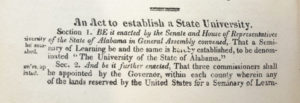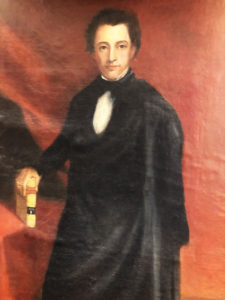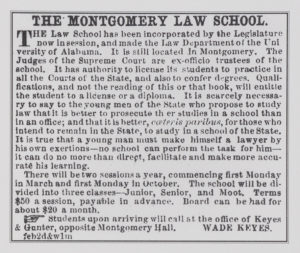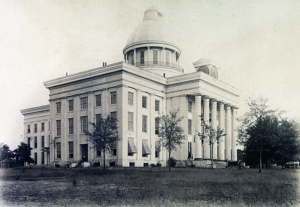Early Foundations and Formative Years
- December 16th, 2022
- by specialcollections
- in 150 Years of UA Law History, General
The following is a post which discusses the early history of the University of Alabama School of Law. It covers incidents, developments, and personalities dating from the 1840s, which saw the earliest efforts to found the school, until the deanship of Albert Farrah, which began in 1913. This post is the first in a series designed to carry us through the highlights of 150 years of Law School history. In this series we shall employ several authors, who will focus on either chronological or topical approaches to the issues at hand.
EARLY FOUNDATIONS AND FORMATIVE YEARS
Consistent with other new territories and states which were emerging during the early nineteenth century, supporters of Alabama realized the importance of establishing an institution of higher education to strengthen the transition from a frontier environment to that of a productive society. On April 20, 1818, the United States Congress approved an act that reserved an entire township in the Alabama Territory “for the support of a seminary of learning.”[1] Almost one year later on March 2, 1819, the Enabling Act for the admission of Alabama to the Union provided for a second township to be added to the land grant to support the institution.[2] By 1820, the General Assembly of the state of Alabama passed “An Act to Establish a State University,” however, the new institution would exist only on paper until it opened its doors at Tuscaloosa eleven years later on April 12, 1831. The new university was charged with the “promotion of the arts, literature, and sciences.”[3] Early course offerings between 1831 and 1845 consisted of: Moral and Mental Philosophy, Ancient Languages, Mathematics, Chemistry and Natural History, English Literature, Mineralogy and Geology, and Astronomy.[4]
The new university was charged with the “promotion of the arts, literature, and sciences.”[3] Early course offerings between 1831 and 1845 consisted of: Moral and Mental Philosophy, Ancient Languages, Mathematics, Chemistry and Natural History, English Literature, Mineralogy and Geology, and Astronomy.[4]
Well into the early nineteenth century, the study of law was typically pursued through the practice of traditional law office apprenticeships. Young men aspiring to practice law as a profession were chosen by judges, or well-established and respected senior lawyers, to “read law” in their offices or chambers. Through the study of select cases, and legal works such as those of William Blackstone and Edward Coke, an apprentice would absorb the required knowledge to pass examination sufficient to be admitted to the bar. The first law schools in the United States were inspired by these law apprenticeships and employed many of the same techniques.[5]
Throughout the nineteenth century, the study of law moved from apprenticeships to the college and university systems that developed throughout the century.[6] By the early 1820s private law schools, which were the first institutions to offer serious professional training, were being absorbed into college and university systems providing prestige as well as the ability to grant degrees.[7] For colleges and universities, this strategy offered the benefit of adding an already established legal training program to their curriculum.[8]
By 1843, trustees at the University of Alabama began examining the idea of adding professional schools to the university. In addition to the notion of adding a medical school to the professional curriculum being considered, university trustees were enthusiastically planning a law school.

The trustees met in December 1845 to establish the guidelines for the new law school, and during the winter of 1845-1846 announced in the university catalogue the appointment of a prominent legal authority and fellow trustee Benjamin F. Porter as the first professor of law.
Unfortunately, Porter’s ambitious plans for the two-year law degree at Alabama were never realized. University trustees had imposed harsh regulations for the law school that assured its secondary status to the regular faculty and university. Restrictions such as prohibiting university students from attending law lectures, not allowing law lectures to be given on the university premises, as well as matters of discipline in which regular university faculty had authority over law students including the power of expulsion were overly restrictive. Furthermore, law students were not allowed access to the university dining hall or university housing. Funding in support of the law program was also problematic. The law professor’s salary was determined by student fees and no university funding was to be used to support the law school. The law school faculty was restricted to a single professor of law who was required to confer with state supreme court judges in planning lectures and selecting textbooks. The university trustees and faculty had imposed regulations and restrictions on the law program which contributed to its failure. As the result, no students registered for classes and the law program foundered.[9]
The second attempt to establish a law department within the University of Alabama reflected the earlier pattern of universities such as Yale in 1824, Harvard in 1829, the University of North Carolina in 1845, and Tulane in 1847, all of which absorbed existing private professional legal training into the university structure.[10] On January 25, 1860, the Montgomery Law School was designated as the “Law Department of the University of the State.”[11] The law school evolved from a series of lectures developed by chancellor of the southern division of Alabama, Wade Keyes.[12]  Born in Limestone County, Alabama in 1821, Keyes studied at LaGrange College, the University of Virginia, and graduated from the law department at Transylvania University at Lexington Kentucky. After extensive travels, Keyes returned to Alabama and soon established himself in the Alabama legal community.[13] He began teaching classes on property law at Montgomery and soon after, the Montgomery Law School developed as an expansion of those lectures.[14]
Born in Limestone County, Alabama in 1821, Keyes studied at LaGrange College, the University of Virginia, and graduated from the law department at Transylvania University at Lexington Kentucky. After extensive travels, Keyes returned to Alabama and soon established himself in the Alabama legal community.[13] He began teaching classes on property law at Montgomery and soon after, the Montgomery Law School developed as an expansion of those lectures.[14]
The state legislature appointed its state supreme court justices as ex officio trustees of the school with the power to assign professorships, create by-laws, and control the real and personal property of the school.[15] Although the school was designated as the Law Department of the University of the State, mutually protective language within the act allowed either the trustees of the University of Alabama, or the Montgomery Law School to dissolve the connection between the two institutions.[16] Very likely this protective agreement was influenced by the earlier administrative failures of the university’s attempt to establish a law program in 1846.
The Montgomery Law School offered students full use of the state and supreme court libraries and classes were conducted within the state capitol.[17]

The curriculum was divided into three levels that included Junior, Senior, and Moot with tuition assessed at fifty dollars for each session. There were two sessions per year, beginning the first Monday in March and the first Monday in October.[18] The law school was authorized to confer degrees and to license students to practice in Alabama’s court system. Additionally, diplomas were awarded based on subjective evaluation of the student’s performance which represented a significant break from the law office apprenticeships that allowed a student to practice law on the completion of a set of quantitative, and often minimum requirements.[19] On this point Keyes noted, “it is scarcely necessary to say to the young men of the State who propose to study law that it is better, caeteris paribus [all things being equal], for those who intend to remain in the State, to study in a school of the State.”[20] Beginning its operations in March 1860, the Montgomery Law School completed two sessions ending in February 1861.
The literal drumbeat of war overshadowed Keyes’ short-lived law school as Alabama had seceded from the Union the previous month and was preparing for war. Although the law school was well organized, administratively sound, had scholarly leadership and good resources, it was not enough to sustain the school through the turbulent and destructive years of the Civil War.[21]
Following the burning of the university by federal troops on April 4, 1865, the University of Alabama struggled to reopen in the challenging postwar world. Eventually the university reopened during the 1871-1872 academic year, although only ten students enrolled, four of them sons of faculty members. In a difficult environment which was amplified by Reconstruction-era political concerns, the university attempted to balance the demands of institutional viability and its desire to provide a faculty free of political influence with mixed success.[22] However, it was during this period that the permanent establishment of the law school was finally realized in February 1872 with the admission of four students; an additional two students were admitted in October. University president Nathaniel Lupton acknowledged the establishment of the law school to the regents, reporting “With proper encouragement on the part of the Regents and the same liberal policy heretofore extended by the faculty I am led to believe that the law department is no longer a mere experiment, but a permanent feature of the University.”[23]
